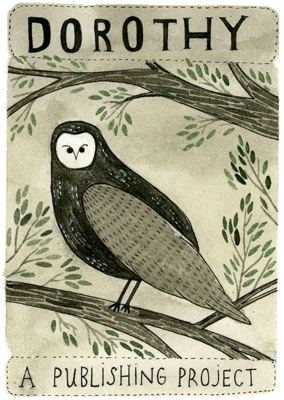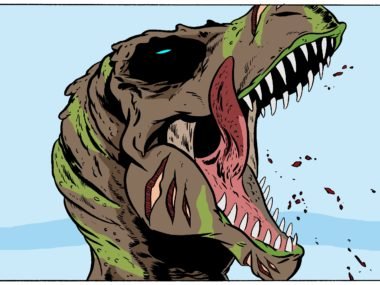
Now in its 10th year, Dorothy, a Publishing Project is a literary publishing house run by writers Danielle Dutton and Martin Riker. Each year, the press publishes two new books simultaneously, with a focus on works of fiction or near fiction or about fiction, mostly by women. Dorothy has been acclaimed–in such publications at the New York Times, Atlantic magazine, and the Paris Review–for the close editorial curation of its list. In addition to publishing important 20th C writers like Leonora Carrington, Barbara Comyns, and Marguerite Duras, the press has debuted some of the most acclaimed writers today, such as PEN-Faulkner awardee Azareen Van Der Vliet Oloomi and NBCC-finalist Nell Zink. The press is named for Dutton’s great-aunt Dorothy Traver, head librarian, author, gardener, animal-lover, and bookmobile-driver, who on each birthday gave her niece a book stamped with an owl bookplate.
STL SPEX (Rachel): Dorothy is known for excellent curation, for carefully selecting just a few particularly interesting books for publication each year. What’s the process for manuscript selection and what are some of the ups and downs of privileging quality over quantity?
Danielle: Manuscripts come to us a number of ways: through open submissions via our website (e.g. Nell Zink’s The Wallcreeper), from agents (though so far we’ve never accepted an agented submission), and as recommendations from trusted editor friends, translator friends, writer friends, and bookseller friends (Nathalie Léger’s Suite for Barbara Loden[translated by Cécile Menon and Natasha Lehrer]came to us this way). There have also been books that we went after rather than having them come to us, such as Jen George’s The Babysitter at Rest, Renee Gladman’s Ravicka series, and The Complete Stories of Leonora Carrington.
As for the selection process: we’re looking for writing that wows us. We often really admire work that doesn’t quite wow us, and sometimes work that wows us obviously isn’t quite where it needs to be. But as vague as it might sound, it’s the wowing that matters. I remember reading one of Kathryn Mansfield’s letters where she says that the cruelest thing anyone could ever say to her about her writing was that it was “competent.” To her, that was the greatest insult. As a reader I kind of agree. What I’m looking for is an unusual energy, not a competency but an overflow of something, an interesting kinetic vibration, even if that vibration is very quiet, very slow, it must be specific, strangely itself.
STL SPEX: Dorothy is also known for beautiful book design – what’s the process for developing/choosing illustrations, paper, font, etc? Any advice for other small presses on this aspect of publishing?
Danielle: When we started the press we made a few important design decisions that we planned to stick with all along, the most important of these being the trim size, which is squarish and therefore somewhat distinct. We had the idea that every Dorothy book would have its own design, but that they would share a trim size, which we hoped would emphasize the project-ness of Dorothy, a publishing project (which is the press’s full mouthful of a name). In other words, we wanted to insist that all of the books were part of one conversation the press was having while also letting each be its own unique object (hence no uniform cover design, although we were tempted by presses that do that so well, such as P.O.L in France or Fitzcarraldo Editions in the UK).
In almost every case I start from scratch with cover design, seeking out a new artist whose work I can use. The exception is that I’ve used a different work by the artist Gisela Insuaste on every one of Renee Gladman’s Ravicka covers. Finding the right art is one of the most stressful parts of the process for me every year. Every year I’m convinced I won’t be able to find something good, and every year I wind up being really delighted with where we wind up. In three cases so far writers have suggested artwork to me: Suzanne Scanlon brought me the photograph we used on Promising Young Women, Jen George asked me to consider work by the artist Lola Rose Thompson, and Sabrina Orah Mark actually owns the original of the painting by Li Shan Chong that we used on the cover of Wild Milk.
I’m not a big believer in unsolicited advice, and not a trained designer, so I wouldn’t presume to give design advice to another press beyond simply encouraging everyone to care about the physical components of their books (but actually even that feels prescriptive as I’m fully aware that I make a fetish out of the physical object of a book).
STL SPEX: I’ve been on a bit of a Leonora Carrington bender since reading The Complete Stories, including going down some rabbit-holes in search of her visual art – and this has been my experience with other Dorothy books as well. I think there’s something about the aesthetic and the prevalence of mysterious content that encourages the reader to seek and find (or hide and seek?). What are your hopes in terms of reader experience/reaction?
Marty: I guess one of our hopes is that everyone has the experience you’ve just described. Really no book should be “just another book,” every book should be an occasion for something new coming into your life. But the experience of legitimate newness in literature—as elsewhere!—isn’t cheap or easy. It’s that special thing you need to seek to find, you need to have some patience and a lot of curiosity, you have to be on the lookout for it and you have to force yourself to reject mere virtuosity, or writing that is well done but not very interesting. Danielle mentioned above the curse of “competence.” As a publisher, it’s actually quite difficult not to want to support writing you admire for being very well done, to support the human accomplishment of it, the virtuosity. But at the end of the day the world is full of books that are very well done, whereas truly interesting newness is not only rare but often hard to recognize right away (that’s the patience part). This is one reason we publish only two books a year, because when you publish a large number of books, and need to keep filling out the season’s list with new titles, it’s quite possible for each book to be excellent, but it’s very unlikely that each will be something new.
STL SPEX: Quite a few of your books, including The Hanky of Pippin’s Daughter by Rosmarie Waldrop, are written by authors who are famous for work in another genre. What draws you to these texts and what are some of the interesting things that happen when writers switch genres?
Marty: Oh I like this observation. I think it probably has to do with the question of conventionality. As a fiction writer you come to your art through a kind of apprenticeship that includes learning the “rules” of the trade. Literary rules are, of course, nothing but the list of ways people have written in the past; they can be valuable to learn, but you also need to move past them in one way or another—I think everybody agrees about this. You can move past them by using your imagination and taking the rules wherever you want to go, or you can start from a different place entirely, a not-fiction place, and thus come to the rules—the traditions of fiction writing—from a different way of thinking. Writers who come to fiction from poetry or visual arts are equipped with ways of thinking about how art operates that are unencumbered by the traditions of fiction making, and the confrontation of those different artistic impulses can yield great originality. Donald Barthelme applies the concerns of modern art to literary fiction and the result is fiction Robert Rauschenberg would write, if Rauschenberg knew a great deal about literary fiction. Leonora Carrington is a sublime surrealist painter whose stories have much more in common with her visual art than with more traditional fiction.
STL SPEX: What other independent presses do you admire and recommend – and what do you like about their work?
Danielle: Actually, one of our favorite indie presses is another with St. Louis ties: Flood Editions. Flood was founded in Chicago, and I think Chicago is their official home, but one of its editors, the poet Devin Johnston, lives with his family here in St. Louis and teaches at SLU. When we were first hatching Dorothy back in 2009, Flood was one of the presses we were looking to as a model. We liked how carefully arranged their list seemed to be, how each book that got added seemed to subtly change the whole list retroactively, and we also admired their gorgeous design (by book-designer extraordinaire Jeff Clark).





